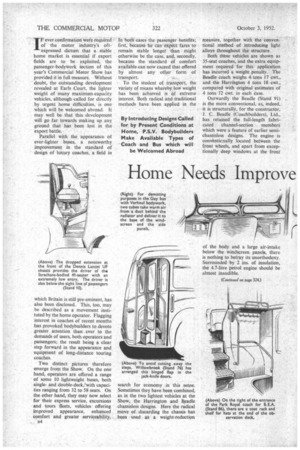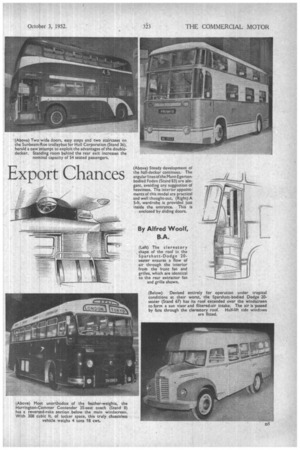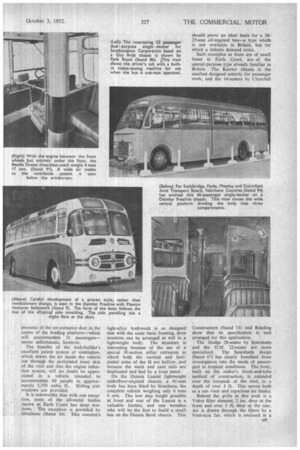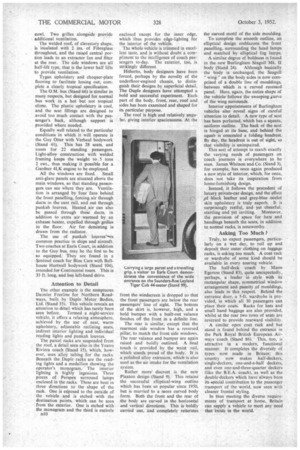Home Needs Improve Export Chances
Page 62

Page 63

Page 64

Page 66

Page 67

Page 68

If you've noticed an error in this article please click here to report it so we can fix it.
By Alfred Woolf, B.A.
IF ever confirmation weie required of the motor industry's oftexpressed dictum that a stable home market is essential if export fields are to be exploited, the passenger-bodywork section of this year's Commercial Motor Show has provided it in full measure. Without doubt, the outstanding development revealed at Earls Court, the lighter weight of many maximum-capacity vehicles, although called for directly by urgent home difficulties, is one which will be welcomed abroad. It may well be that this development will go far towards making up any ground that has been lost in the export battle.
Parallel with the appearance. of ever-lighter buses, a noteworthy improvement in the standard of design of luxury coaches, a field in which Britain is still pre-eminent, has also been disclosed. This, too, may be described as a movement instituted by the home operator. Flagging interest in coaches of recent months has provoked bodybuilders to devote greater attention than ever to the demands of users, both operators and passengers; the result being a clear step forward in the appearance and equipment of long-distance touring coaches.
Two distinct pictures therefore emerge from the Show. On the one hand, operators are offered a range of some 10 lightweight buses, both singleand double-deck,'with capacities ranging from 32 to 58 seats. On the other hand, they may now select for their express service, excursions and tours fleets, vehicles offering improved appearance, enhanced comfort and greater serviceability.
D4 In both cases the passenger benefits; first, because he can expect fares to remain stable longer than might otherwise be the case, and, secondly, because the standard of comfort available can now exceed that offered by almost any other form of transport.
To the student of transport, the variety of means whereby low weight has been achieved is of extreme interest. Both radical and traditional methods have been applied in the search for economy in this sense. Sometimes they have been combined, as in the two lightest vehicles at the Show, the Harrington and Eeadle chassisless designs. Here the radical move of discarding the chassis has been used as a weight-reduction Measure, together with the conventional method of introducing light alloys throughout the structure.
• Both these vehicles are shown as 35-seat coaches, and the extra equipment required for this application has incurred a weight penalty. The Beadle coach weighs 4 tons 17 cwt., and the Harrington 4 tons 18 cwt.; compared with original estimates of 4 tons 12 cwt. in each case.
Outwardly the Beadle (Stand 91) _ is the more conventional, as, indeed, it is structurally, for the constructor, 3. C. Beadle (Coachbuilders), Ltd., has retained the full-length fabricated channel-section members which were a feature of earlier semichassisless designs. The engine is conv6nticna1ly located between the front wheels, and apart from exceptionally deep windows at the front of the body and a large air-intake below the windscreen panels, there is nothing to betray its unorthodoxy. Surrounded by 2 ins, of insulation, the 4.7-litre petrol engine should be almost inaudible. The Harrington coach (Stand 8), rather courageously named "Contender," is more apparently a break with tradition. The deep windscreen, with its glazed "reverse angle" section below, causes eyebrows to rise, for it is an unexpected detail in a vehicle built by this concern. Its practical value appears to be undoubted, however.
Some indication of the adaptability of the design is seen in the version for British Overseas Airways Corporation. It consists of deep, trans
verse beams linking box-section pillars and a double-skinned fully stressed roof, SQ that the torsional loads set up in a moving vehicle are dispersed throughout the entire structure and are not concentrated in any particular component.
The B.O.A.0 coach has two entrances with hinged doors, a locker occupying the entire rear of the body, which, together with side compartments, provides 308 cubic ft. of luggage space and capacious interior parcel lofts. A demonstration model seen at the Show has 41 seats, a flush-fitting sliding door, Clayton heating, a glazed dome to the roof and weighs only 4 tons 13 cwt. A 44-seat bus version of the design is expected to weigh only 4 tons 7 cwt.
Another novel design is the Seddon 32-seat central-engined bus. This, in the version for West Riding Automobile Co., Ltd. (Stand 69), provides ample accommodation for 32 passengers and weighs merely 4 tons 19 cwt.
High, narrow steps are one disadvantage of the design, which, however, is more than balanced by the admirable under-cover accessibility to the engine. The almost vertical full front of this design, coupled with a bulkhead behind and beside the driver's seat, offers excellent visibility and promises to reduce dazzle to a satisfactory level.
D6 Three Atkinson Alpha vehicles, two with Willowbrook 44-seat bodywork for the North-Western Road Car Co., Ltd., and the third in chassis form, are revealing from the point of view of weight-saving possibilities. The version shown inside Earls Court by Willowbrook (Stand 76) weighs 5 tons 10 cwt., unladen, and is equipped with single Michelin D20 tyres all round, parcel racks, heating and demisting equipment. This is powered by a Gardner 5HLW engine, and seems entirely satisfactory for every type of stage carriage operation, despite the absence of exterior mouldings, cappings and the like. Indeed, the interior finish in particular is attractive, although plain. In the demonstration park was seen an identical bus with a 4HLW engine, one of the first to be so equipped that has been displayed. This weighs 5 tons 5 cwt. complete and a short run indicated that power was ample, although high speeds were obviously beyond its scope. For flat country, the economy and solidity of the vehicle would be more than adequate.
Proportionally lighter in weight is the M.C.W. Hermes single-deck body, which although not seen at Earls Court, promises to bewidely
distributed throughout the world before long. This steel and lightalloy structure weighs 32 cwt. in 44seat form.
Mounted on a Leyland Tiger Cub chassis, an unladen weight of 5 tons 7 cwt. is achieved, some 5 cwt. less than a comparable export version, fitted with the M.C.W. Jason body.
This particular product is inevitably comparable with the SaundersRoe Saro single-deck body, which weighs 36 cwt. This, however, is entirely of light alloy, and incorporates interior mouldings, stoveenamelled window-frame cappings, polished advertising-space surround mottaings and similar features. Its appearance is therefore more strictly comparable with that of the sort of vehicle which one has become accustomed to seeing.
Operators and public alike will appreciate the particularly wide entrance to this vehicle, as well as the easy steps. The floor of the Show model is covered by SafetyWalk, a new material embodying a carborundum surface which entirely eliminates the danger of slipping, even in wet weather. In finish and appearance generally, the Saro 44seat body offers remarkable value, whilst the design lends itself to further weight pruning, to the detriment of superficial appearance.
An indication of this is evident in the Saro double-deck body. Early models, minus mouldings, capping% and such-like, weighed 6f tons or so, and the version on show at Earls Court, based on a Guy Arab chassis for Birmingham Corporation, is only a ,little heavier. This despite the fact that all the features, such as swaged waist panels, multiple ventilators, wheel discs and cab details standardized on the vehicles of Britain's biggest municipal fleet, have been retained. Nevertheless, a reduction of 18 cwt. in the unladen weight of the vehicle has been achieved, compared with others operated by the undertaking.
The decline of the double-decker which has been evident in the past two years or so, may well be arrested by the efforts of Daimler, MetropolitanCammell-Weymann and Hull Corporation.A joint effort of the first two, the Daimler CLG 58-seater with M.C.W. bodywork for 'Potteries Motor Traction (Stand 26), undoubtedly indicates a trend.
This outstanding vehicle weighs only 6 tons 2 cwt., the body itself representing 1 ton 16 cwt. 1 qr. of the total. This is a reversion to normality in a way, for here is a double-decker which weighs less than many single-deckers.
Even the body, proudly named Orion—surely an indication of a resurgence of interest—is almost as light as that of a single-decker. Steel and aluminium are employed in the structure, the former where stresses are concentrated, and the latter where bracing is required or a means for providing shape is essential.
Inside the vehicle, the secret of the low weight is literally revealed, for the H-section tubular pillars are not concealed behind panelling and mouldings, the floor is devoid of rubbing strips, hand rails are provided only over the rear longitudinal seats, and there are no vertical handpoles, polished window cappings or even panel trimming.
Two sliding windows only are provided on the lower deck, four on the top deck, and the inner lining panels are swaged to increase elbow room and prevent drumming. The battery is mounted on the floor of the lower deck, instead of being slung underneath.
The external appearance of the vehicle is similarly austere. The front and rear canopies are formed of single pressings, into which the fixed front and side windows are rubber-glazed directly. An examination of the structure provides proof that strength has not been abandoned in the search for light weight.
Light weight in trolleybuses is less
urgently required, but the possibility of an extension of its undoubted advantages and of improving the revenueearning capacity of the trolleybus are provided by the Hull Corporation double-decker, seen on the Sunbeam stand, No. 36. This has two doors, a very wide front entrance, down to which the floor is ramped to provide a low step, and an equally convenient rear exit. Two staircases are provided, so that seating is reduced to 54.
Ample standing room for up to 16 passengers exists behind the rear exit, and although two men would normally be required to operate the vehicle, the intimate contact which the driver enjoys with boarding passengers—far more, incidentally than is possible with any motorbus hitherto seen—suggests that in off-peak hours on quiet routes a driver would be quite capable of controlling the entire vehicle. This trolleybus is based on a Sunbeam MF2T1 chassis with a 15-ft. 6-in, wheelbase and the body is by Charles H. Roe.
Another• maximum-capacity vehicle, of the type which has become public transport's guinea-pig in Britain, is the Daimler Freeline for Stalybridge, Hyde, Mossley and Dukinfield Joint Transport Board, shown by Northern Counties (Stand 94). This provides accommodation for 60 passengers, of which 34 are seated on each side of a 4-ft.-wide central entrance. The presence of the air-extractor duct in the centre of the loading platform—which will accommodate 16 passengers— seems unfortunate, however.
The benefits of the bodybuilder's excellent patent system of ventilation, which draws the air inside the vehicle out through the perforated inner skin of the roof and into the engine induction system, will no doubt be appreciated in a vehicle intended to accommodate 60 people in approxi mately 1,350 cubic ft.. Sliding side windows are provided.
It is noteworthy that with one exception, none of the all-metal bodies shown at Earls Court has drop windows. The exception is provided by Strachans (Stand 10). This concern's light-alloy bodywork is so designed that with the same basic framing, drop windows can be arranged at will in a lightweight body. The structure is interesting because of the use of a special H-section pillar extrusion in which both the vertical and horizontal arms of the H are hollow, and because the waist and cant rails arc duplicated and tied by a truss panel.
On the Dennis Lancet lightweight underfloor-engined chassis, a 4I-seat• body has been fitted by Strachans, the complete vehicle weighing only 6 tons 9 cwt. The low step height possible at front and rear of the Lancet is a valuable feature, and one wonders who will be the first to build a small bus on the Dennis Stork chassis. This
should prove an ideal basis for a 2025-seat oil-engined bus—a type whiCh is not available in Britain, but for which a definite demand exists.
Such examples as there are of small buses at Earls Court, are of the special-purpose type already familiar in Britain. The Karrier chassis is the smallest designed entirely for passenger work, and the 14-seaters by Churchill Constructors (Stand 11) and Reading show that its specification is well arranged for this application.
The Dodge 20-seater by Sparshatts and the O.M. 22-seater are more specialized. The Sparshatts design (Stand 67) has clearly benefited from investigation into the needs of passengers in tropical conditions. The body, built on the maker's block-and-tube method of construction, is extended over the forepeak of the roof, to a depth of over 1 ft. This serves both as a sun visor and capacious air intake.
Behind the grille in this peak is a Vokes filter element, 2 ins, deep at the front and over 1 ft. deep at the rear. Air is drawn through the filters by a Vent-axia fan, which is enclosed in a cowl. Two grilles alongside provide additional ventilation.
The welded roof, of clerestory shape, is insulated with 2 ins. of Fibreglass throughout, and the raised central portion leads to an extractor fan and filter at the rear. The side windows are all half-lift type, that is the lower half lifts to provide ventilation.
Tygan upholstery and chequer-plate flooring to facilitate hosing out, complete a clearly tropical specification.
The O.M. bus (Stand 66) is similar in many respects, but designed for normal bus work in a hot but not tropical clime. The plastic upholstery is cool, and the seat fillings are designed to avoid too much contact with the passenger's back, although support is provided where needed.
Equally well related to the particular conditions in which it will operate is the Guy Otter with Verheut bodywork (Stand 41). This has 28 seats, and room for 22 standing passengers. Light-alloy construction with welded framing keeps the weight to 5 tons 2 cwt., thus making it possible for a Gardner 4LK engine to be employed.
All the windows are fixed. Small anti-glare panels are situated above the main windows, so that standing passengers can see where they are. Ventilation is arranged by four fans behind the front panelling, forcing air through ducts in the cant rail, and out through punkah louvres. Heated air can also be passed through these ducts, in addition to extra air warmed by an exhaust heater, expelled through grilles in the floor. Air for demisting is drawn from the radiator.
The use of punkah louvres"‘is common practice in ships and aircraft. Two coaches at Earls Court, in addition to the Guy bus, may be the first to be so equipped. They are found in a sentinel coach for Blue Cars with Bellhouse Hartwell bodywork (Stand 104), intended for Continental tours. This is 33 ft. long, and has left-hand drive.
Attention to Detail
The other example is the sumptuous Daimler Freeline for Northern Roadways, built by Duple Motor Bodies, Ltd. (Stand 55). This vehicle reveals an attention to detail which has rarely been seen before. Termed a night-service vehicle, it offers a relaxing atmosphere, achieved by the use of neat, warm upholstery, adjustable reclining seats, indirect interior lighting and individual reading lights and punkah louvres.
The parcel racks are suspended from the roof, a detail seen also in the Yeates Riviera coach (Stand 15), which, however, uses alloy tubing for the racks. Beneath the Duple racks are the reading lights and a medallion showing the operator's monogram. The interior lighting is highly ingenious. Three pieces of Perspex surround lamps enclosed in the racks. These are bent in _three directions to the shape of the rack. One is eiposed to the outside of the vehicle and is etched with the destination points, which can be seen from the exterior. One is etched with the monogram and the third is entirely 010 enclosed except for the inner edge, which thus provides edge-lighting for the interior of the vehicle.
The whole vehicle is trimmed in excellent taste, and is without doubt a compliment to the intelligence of coach passengers to-day. The exterior, too, is strikingly different.
Hitherto, body designers have been forced, perhaps by the novelty of the underfloor-engined chassis, to distinguish their designs by superficial detail, The Duple designers have attempted a bold and successful experiment. Each part of the body, front, rear, roof and sides has been examined and shaped for its particular purpose.
The roof is high and relatively angular, giving interior spaciousness. At the
front the windscreen is dropped so that the front passengers are below the rear passengers' line of sight. The bottom of the skirt is, however, high, and a bold bumper with a built-out valance finishes off the front. in a definite line.
The rear is similar, except that the rearmost side window has a reversed pillar, to match the front side windows.
• The rear valance and bumper are again raised and boldly outlined. A final touch is provided by the waist rail, which stands proud of the body. It is a polished alloy extrusion, which is also used as the air intake for the ventilation system.
Rather more discreet is the new Plaxton design (Stand 9). This retains the successful elliptical-wing outline which has been so popular since 1950, but is married to a more curved body form. Both the front and the rear of the body are curved in the horizontal and vertical directions. This is boldly carried out, and completely reiterates the curved motif of the side moulding.
To complete the smooth outline, an elliptical design emblazons the front panelling, surrounding the head lamps and matched by elliptical fog lamps.
A similar degree of boldness is found in the new Burlingham Seagull Mk. II body (Stand 24). Although basically the body is unchanged, the Seagull " wing " on the body sides is now comprised of .a double line of mouldings, between which is a curved recessed panel. Here, again, the entire shape of the vehicle follows the sweeping „gurve of the wing surrounds.
Interior appointments of Burlingham vehicles also reveal signs of careful attention to detail. A new type of seat has been perfected, which has a square, uniform outline. The back of the seat is hinged at its base, and behind the squab is concealed a folding headrest. By day, the headrest is out of sight, so that visibility is unimpaired.
This sort of attempt to match exactly the varying needs of passengers on coach journeys is everywhere to be seen. James Whitson and Co. (Stand 3), for example, has once again produced a new styie of interior, which, for once, does not take its inspiration from home-furnishing design.
Instead, it follows the precedent of luxury private-car design, and the effect „of black leather and grey-blue ocelot skin upholstery is truly superb. It is surprisingly restful, and yet cheerful; startling and yet inviting. Moreover, the provision of space for hats and handbags beneath the seats, in addition to normal racks, is noteworthy.
Asking Too Much ?
Truly, to expect passengers, particularly on a wet day, to roll up and deposit their outer clothing on luggage racks, is asking too much. A coat rack or wardrobe of some kind should be available in every touring vehicle.
The half-deck coach by Mann Egerton (Stand 83), quite unexpectedly, perhaps, a leader in style with its rectangular shape, symmetrical window arrangement and paucity of mouldings, also leads in this respect. Behind the entrance door, a 5-ft. wardrobe is provided, in which all 50 passengers can place their coati Racks for hats and small hand baggage are also provided, whilst at the rear two rows of seats are reversed to provide rearward visibility.
A similar open coat rack and bat stand is found behind the entrance in the Park Royal British European Airways coach (Stand 86). This, too, is attractive in a modern, functional manner. It completes the diversity of types now made in Britain; this country now makes half-deckers, single-deckers, one-and-a-half deckers, and even one-and-three-quarter deckers (like the B.E.A. coach), as well as the double-deckers which have always been its special contribution to the passenger transport of the world, now seen with cleaner frontal styling.
In thus meeting the diverse requirements of transport at home, Britain can supply a vehicle to meet any need that exists in the world.




















































































































































